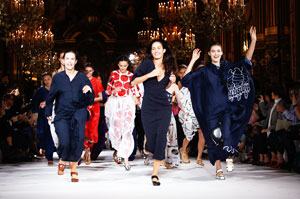Fashion Feels Fur's Warm Embrace
Did the designers forget that wearing fur is fraught with controversy? Or did they simply stop caring?
There were fancy fox cuffs (Oscar de la Renta), wild-looking coyote capes (Michael Kors), bizarrely colorful mink jackets (Chris Benz, Peter Som), knitted furs (Proenza Schouler, Diane Von Furstenberg) and capes trimmed with raccoon tails (for men, courtesy of Thom Browne). The following week, the runways of Milan were perhaps even hairier, from the fur-collared coats at Prada to the fox mukluks at D & G.
For the first time in more than two decades, more designers are using fur than not. Almost two thirds of those in New York are, based on a review of more than 130 collections that were shown on Style.com last month, which is a surprising development during a recession. And it didn' t just happen because of some idea that was floating around in the collective designer ether.
Rather, fur became a trend because of a marketing campaign.
Over the last 10 years, furriers have aggressively courted designers, especially young ones, to embrace fur by giving them free samples and approaching them through trade groups — sometimes when they are still in college. Last summer, for example, the designers Alexander Wang and Haider Ackermann, plus Alexa Adams and Flora Gill of Ohne Titel were flown to Copenhagen for weeklong visits to the design studios of Saga Furs, a marketing company that represents 3,000 fur breeders in Finland and Norway. Saga Furs regularly sponsors such design junkets. The designers were given carte blanche to use fur with state-of-the-art techniques.
Mr. Wang and the Ohne Titel designers ended up including fur in their fall collections. Mr. Ackermann, in Paris, included fur scarves and a narrow wool jacket with ribbons of fur protruding from its collar.
"We were seeing all of these new possibilities in which you can use fur in a very light way," Ms. Adams said. "Fur gives a richness in texture. It's like discovering something new that also has an interesting history."
Several young designers echoed that sentiment, saying they were less interested in fur as a luxury statement or an act of defiance than as a novel design. Mr. Wang said he had not intended to use fur in his collection but decided to after seeing so many plush fabrics that resembled fur. "The point was to create that rich, luscious feel while blending the lines between what was real and what was fake," he said.
In Denmark, Ms. Adams said, she learned of a technique of sewing extremely thin, evenly spaced strips of fox onto a layer of silk, creating the look of a fox coat with a third of the weight and expense. For their show, she and Ms. Gill showed a version in army green. Carine Roitfeld, the editor of French Vogue, admired it, so the designers sent the sample, which would cost $10,400 in a store, to her hotel for her to wear throughout Fashion Week. Ms. Roitfeld was photographed so often in the coat that they decided she could keep it. After all, their cost to make it was nothing.
Much like lobbying groups in Washington, various cooperatives representing breeders, farmers and auction houses around the world solicit designers to use their furs. Saga, one of the biggest cooperatives, provided the furs used this season by the New York labels Cushnie et Ochs, Thakoon, Brian Reyes, Wayne, Derek Lam, Proenza Schouler and Richard Chai, in addition to Ohne Titel and Alexander Wang.
Another cooperative, the North American Fur Auctions (NAFA) in Seattle, gave furs to the newcomers Bibhu Mohapatra and Prabal Gurung and worked with marquee designers who make separate fur collections, including Carolina Herrera, Oscar de la Renta and Michael Kors.
"We'll give them furs to make three, four, five, even six different garments," said Steve Gold, a marketing director for the North American group, which represents farmers in Canada and the United States. "The quid pro quo is simply that they mention our name to the press."
Neither marketing group would disclose its budget, but Mr. Gold said it was typical to spend "hundreds of thousands of dollars" each year.
"We want to make sure fur is on the pages of magazines around the world," he said. "The way to do that is to facilitate the use of fur by designers."
Their success has infuriated anti-fur activists like Dan Mathews, the senior vice president of People for the Ethical Treatment of Animals, who described the fur marketing as "a smoke and mirrors campaign, where they give designers money and free fur to accessorize the runway, even though that stuff never ends up in shops."
Several of those designers are too young to remember the vicious battles over fur in the 1980s and 90s, when a PETA member tossed a dead raccoon onto the plate of Anna Wintour while she was dining at the Four Seasons; another tossed a tofu cream pie in Mr. de la Renta’s face. But some remain sheepish on the subject. Thakoon Panichgul, for example, showed a coat in his fall collection with strips of fox bursting from the sleeves, but he declined to be interviewed for this article because of the controversy.
Others said they felt confident using fur after examining the chain of production and finding it humane.
"You see so much leather and shearling being used this season, and no one is complaining about that," Ms. Adams said. "I don't see the difference between using shearling and using fur."
Saga sponsors courses and competitions at design schools, including at the Fashion Institute of Technology and Parsons the New School for Design (as does PETA).
"We bring them knowledge about fur early in the design process," said Charles Ross, the director of international activities for Saga.
That is how Irina Shabayeva, the winner of the sixth season of "Project Runway," was introduced to fur. In 2003, while a student at Parsons, Ms. Shabayeva won a fur design contest sponsored by Saga. The prize was a trip to Scandinavia. After Ms. Shabayeva started her own collection, Saga introduced her to Funtastic Furs, a company that makes furs for designers like Peter Som and Catherine Malandrino.
"They were kind enough to sew up a few pieces for me," Ms. Shabayeva said. Actually, her fall collection looked as if it had been conceived in a taxidermist's studio. The opening look was a dress made of the long plumes of a pheasant.
The sales of fur in the United States, and its appearance on the runways, fell in the 1980s as a result of the aggressive protests. But attitudes began to change, and fur began to make a slow comeback, from sales under $1 billion in this country in the early 90's to $1.8 billion in 2006, according to figures released by the Fur Information Council of America. Naomi Campbell, who once posed for PETA, now has a fur coat named after her at Dennis Basso.
But many of those gains were erased in the last three years, following an unusually warm winter in 2007, and then the recession. There was little fur on the runways in 2009, as designers sought to rein in prices.
Now, as fur is becoming trendy, skin prices at auction have shot up in response to increased demand; the price of a male mink pelt approaches $100 in Finland, up 40 percent over last year. A silver fox pelt is now $200, up 20 percent.
That raises questions about how good this trend will be for the designers, should stores buy their furs. Most have little experience in the fur market, and they will have to pay for the specialized production of their designs, which is far more expensive than ready-to-wear made from fabric. And if their fur pieces don’t sell next fall, they will be stuck with a lot of expensive coats.
"That's a big question mark," said Brian Reyes, whose show included several pieces made for him by Funtastic Furs. "The fur industry has different ways of buying or selling. Who buys it? Where does fur sell well? It's all a new experience."
In his showroom sits a big cobalt blue fox coat — so big, Mr. Reyes said, it could stand up on its own. The price was $6,750. Though he showed several fur coats, he does not expect to sell many this year, as he is just beginning to test the market and wants to be cautious.
But other designers are already taking orders. Ohne Titel sold more than 15 shearling and fox vests, priced under $2,000, in the days after its show. Derek Lam, who has worked with Saga for several years, has found fur designs to be lucrative. From his pre-fall collection in 2008, Mr. Lam sold 148 short riding jackets trimmed with mink, which cost $1,990. Now Mr. Lam offers furs priced from $4,500 to $30,000.
"If you sell two," said Jan-Hendrik Schlottmann, the chief executive of Derek Lam, "you are doing really well."
Of the fox coat worn by Ms. Roitfeld, even without the sample, Ohne Titel already has orders from stores for 10.
POST: 2025-04-19
More Apparel Brand News
- 06-02· Rihanna Reinvents the Shirt Dress With a Simple Styling Trick
- 06-02· Trump Announces America’s Exit From the Paris Climate Accord
- 09-07· Bella Hadid Joins Her Sister as a Victoria's Secret Model
- 09-06· I know my children, Honor and Haven, are growing up in a safer home because of our products.
- 09-06· This is How You Get More Followers on Social Media
- 09-05· This Is What the New Look of Leadership Really Looks Like
- 09-05· The Celebrity Guide to Emerging From the Ocean Gracefully
- 08-25· The Jungle Book Gets the Hollywood Treatment, a Reason to Toast to Kate Moss Breast, and More of the News You Missed Today
- 05-19· Creativity Without Commercial Restraints at SCAD's Annual Student Fashion Show
- 05-16· A.P.C. Invests in Vanessa Seward's New Label

- 05-281FRANCO FERUZZI : wallet
- 05-212BETTA : Babies Slippers
- 05-093NAVIGARE : BUSINESS ISSUE
- 05-014KAYEE : Kaye Ka Italian casual ar
- 05-015KAYEE : Men's trousers
- 04-256CABLE&CO. : mens shoes
- 04-107ROMUS : returns on efective shoes
- 03-278MONDI : Pants
- 03-069LINDI : Tunic
- 02-2310KOSHA : Order
 Fashion News
Fashion News
- Rihanna Reinvents the Shirt Dress With a Simple Styling Trick
- Trump Announces America’s Exit From the Paris Climate Accord
- Bella Hadid Joins Her Sister as a Victoria's Secret Model
- I know my children, Honor and Haven, are growing up in a safer home because of our products.
- This is How You Get More Followers on Social Media
- This Is What the New Look of Leadership Really Looks Like

















